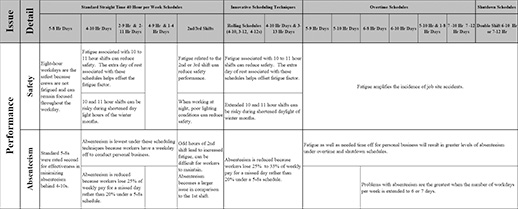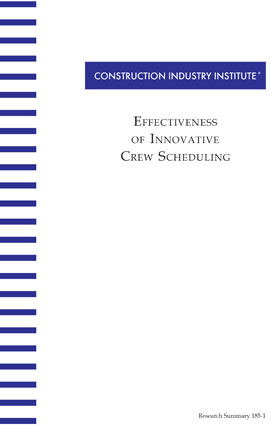
Look-Up Table for Crew Scheduling
Several crew scheduling options are available to contractors and owners when they need to complete a project on time or compress or accelerate a schedule. Techniques such as overtime, shift work, rolling or straight four-ten hour days, and other innovative schedules each have their own set of unique benefits and requirements for proper application. The focus of this research project was to document the impacts and proper applications of various crew scheduling techniques as used in the construction industry.
The quantitative portion of this research focused on the five eight-hour days per week, four 10-hour days per week, five 10-hour days per week, and six 10-hour days per week scheduling techniques because of the availability of data as received in the distributed “macro” data collection form.
The information presented in this research report was collected from two main sources. First, industry opinions regarding several crew scheduling techniques were obtained through the use of questionnaires delivered to a diverse group of nearly 1,300 contractors, owners, and labor union representatives throughout the United States. The second source of information came in the form of actual project productivity data collected from over 100 projects completed with a variety of crew scheduling techniques.
A summary of the information collected through the course of this research is organized in a tabular format and presented in Chapter 6 of the research report. The table (Table 6.2) is intended to aid construction professionals in the selection of a crew scheduling technique that will meet the requirements of a specific project. It is expected that the compiled survey responses and rankings, the table and the developed predictive productivity model will assist individuals industry-wide in their understanding of the impacts of crew scheduling techniques and in their selection of crew schedules for specific projects.
Contractors and owners will be the main beneficiaries of this research. The report offers comments, ratings, and productivity data (provided by over 150 contractors, owners, and labor union representatives from a broad range of the construction industry) regarding several innovative crew scheduling techniques, their impacts, and their appropriate uses. The insight provided in this report will help contractors and owners in the following ways:
- When special needs arise on a project, the use of an innovative crew scheduling technique may be a solution. The key information learned through this research was summarized in sections 6.2 and 6.3 of the report.
- The quantitative portion of this research produced a model that can be used to estimate the labor productivity level of a project once the crew schedule is selected. If a project is initiated with knowledge that it must be completed on a compressed schedule basis, the final model presented in Chapter 5 of the report (Equation 5.5) can be used to estimate the productivity associated with a given crew schedule.
- Owner mandated conditions sometimes require the implementation of a schedule compression technique unexpectedly during a project. When an overtime schedule is used to reduce project duration, the contractor deserves proper compensation for the associated productivity losses. When extended duration overtime is used, the model presented in Chapter 5 of the report (Equation 5.4) can be used to accurately estimate the productivity loss associated with the overtime schedule used. The value arrived at can then be used to determine the cost of schedule acceleration to the contractor.
It is important to note that all information included in the “macro” study represents the cumulative productivity for the duration of the analyzed projects. The models are designed to aid in the estimation of the expected productivity levels for the entire project or, upon project completion, to determine the approximate percentage of productivity gain or loss associated with the crew schedule used. The developed models are not intended to be applied to small portions of a project such as in predicting the productivity loss associated with a short duration overtime schedule.
Includes the Excel® spreadsheets that help in selecting crew schedules based on project factors. The table compares each crew scheduling technique, the project characteristics, and the issues that may be impacted by the use of different crew schedules. The tool is intended to aid construction professionals in the selection of a crew scheduling technique that will meet the requirements of a specific project.


